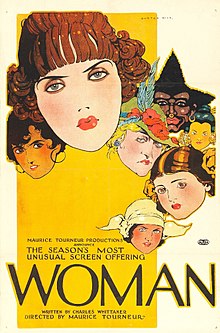Woman (1918 film)
| Woman | |
|---|---|
 Film poster | |
| Directed by | Maurice Tourneur |
| Written by | Charles E. Whittaker |
| Produced by | Maurice Tourneur |
| Cinematography | John van den Broek René Guissart |
| Music by | Hugo Riesenfeld Edward Falck |
| Distributed by | State Rights: Hiller & Wilk |
Release date |
|
Running time | 70 minutes; 7 reels |
| Country | United States |
| Language | Silent (English intertitles) |
Woman, also known by its french title L'Éternelle Tentatrice is a 1918 American silent drama film directed by Maurice Tourneur, an allegorical film showcasing the story of women through points in time. Popular in its day, the film was distributed in the State's Rights plan as opposed to a major distributor, like Paramount Pictures or Universal Pictures.[1][2][3]

Some scenes were shot at Bar Harbor, Maine. It was here that one of Tourneur's cameramen, John van den Broek, lost his life while filming a scene close to the raging Atlantic Ocean. His body was swept out to sea and never found.[1]
Plot
[edit]As described in a film magazine,[4] a modern man and woman quarrel and, in reaction to his wife, the husband recalls all the women in history who have failed their husbands or lovers. Being in an unpleasant state, he recalls Adam in the garden with a very vain Eve who disports herself in a Broadway fashion and causes the downfall of caveman-like Adam.
Then he dwells on the hideous betrayal of Claudius by an unfaithful Messalina. Next he recalls the useless ruination of Abelard by the charming Heloise. Following this episode he remembers Cyrene(Story that seems to be inspired from Selkies) and the fisherman, where the wife basely deserted her husband and children to swim once more in her seal skin that had been hidden from her for many years.
A particularly disagreeable episode in which a young woman during the American Civil War sacrifices a wounded soldier for a bauble. After this the modern woman returns and pins up a Red Cross poster, and the modern man sees the many women of today as more or less uninspiring.
An epilogue noted how World War I made men realize the true value of women, and that women are working towards victory through good works in the Red Cross and other jobs.The film ends with the martyrdom in Europe of nurse Edith Cavell.
Cast
[edit]- Florence Billings as The Woman
- Warren Cook as The Man
- Ethel Hallor as Eve
- Henry West as Adam
- Flore Revalles as Messalina
- Paul Clerget as Claudius
- Diana Allen as Heloise
- Escamillo Fernandez as Abelard
- Gloria Goodwin as Cyrene
- Chester Barnett as The Fisherman
- Faire Binney as The Girl
- Warner Richmond as The Officer
- Lyn Donaldson
- Rose Rolanda
Preservation
[edit]Prints of this film are held at Cineteca Del Friuli, Germona, the Museum of Modern Art, New York, and Gosfilmofond of Russia, Moscow, and in private collections.[5]
See also
[edit]References
[edit]- ^ a b Progressive Silent Film List: Woman at silentera.com
- ^ The American Film Institute Catalog Feature Films: 1911-20 by The American Film Institute, c.1988
- ^ The AFI Catalog of Feature Films: Woman
- ^ "Reviews: Woman". Exhibitors Herald. 7 (23). New York City: Exhibitors Herald Company: 23. November 30, 1918.
- ^ "American Silent Feature Film Survival Catalog: Woman". The Library of Congress. Archived from the original on March 23, 2016.
External links
[edit]- Woman at IMDb
- Woman synopsis at AllMovie
- 1918 films
- American silent feature films
- Films directed by Maurice Tourneur
- American war drama films
- 1910s war drama films
- American black-and-white films
- Cultural depictions of Adam and Eve
- Cultural depictions of Claudius
- 1918 drama films
- American Civil War films
- Films about cavemen
- Films based on the Book of Genesis
- Films set in the 1st century
- Films set in the 12th century
- Films set in the Roman Empire
- Films shot in Maine
- 1910s American films
- Silent American drama films
- Silent war drama films
- Films scored by Hugo Riesenfeld
- Films about women
- 1910s American film stubs
- War drama film stubs
